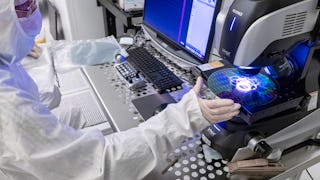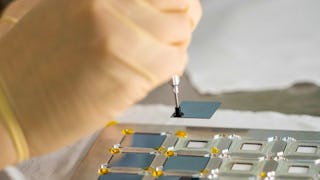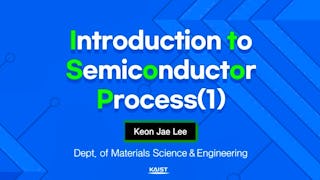This course will provide information on the various stages of semiconductor package manufacturing, including sort, assembly, and final test. In addition, we will also describe how to select, build, and test the packages with the die and other components to ensure the quality of the package and total assembly performance. We will also discuss the role of Process Control Systems in semiconductor manufacturing as they relate to quality testing. Specifically, we will explore how Process Control Systems can help identify and correct process problems that cause variation and quality issues. Finally, we also demonstrate how to use control charts to monitor the process performance. These can assist in decision-making, specifically when to take action to improve the process.
通过 Coursera Plus 解锁访问 10,000 多门课程。开始 7 天免费试用。


Semiconductor Packaging Manufacturing
本课程是 Semiconductor Packaging 专项课程 的一部分

位教师:Terry Alford
3,932 人已注册
包含在 中
您将学到什么
Learn about the various stages of semiconductor package manufacturing.
The role of Process Control Systems in semiconductor manufacturing.
How Process control Systems can help identify and correct process problems.
How to use control charts to monitor process performance.
您将获得的技能
要了解的详细信息

添加到您的领英档案
7 项作业
了解顶级公司的员工如何掌握热门技能

积累特定领域的专业知识
- 向行业专家学习新概念
- 获得对主题或工具的基础理解
- 通过实践项目培养工作相关技能
- 获得可共享的职业证书

该课程共有8个模块
Welcome to Semiconductor Packaging Manufacturing, where we discuss the various stages of semiconductor package manufacturing, including sort, assembly, and final test. In addition, we will also describe how to select, build, and test the packages with the die and other components to ensure the quality of the package and total assembly performance. We will also discuss the role of Process Control Systems in semiconductor manufacturing as they relate to quality testing. Specifically, we will explore how Process Control Systems can help identify and correct process problems that cause variation and quality issues. Finally, we also demonstrate how to use control charts to monitor the process performance. These can assist in decision-making, specifically when to take action to improve the process.
涵盖的内容
1个视频2篇阅读材料
In this module you will watch a lecture video by Principal Engineer, Dr. Mitul Modi from Intel as he discusses semiconductor package manufacturing. He will explain how semiconductor packaging is a complex process and discuss the three primary phases: sort, assembly, and final test.
涵盖的内容
1个视频2篇阅读材料1个作业
In this module, Dr. Mitul Modi discusses process flows for different types of semiconductor packages. He will explain how most process flows consist of three basic steps: sort, assembly, and final test. You will learn the details of how these steps vary depending on the package type. Mitul will give examples of process flows for BGA, LGA, 3D stacked LGA, and Stacked Hybrid packages. He will also mention that there are many more possible scenarios for process flows in semiconductor packaging.
涵盖的内容
1个视频2篇阅读材料1个作业
In this module, Dr. Mitul Modi discusses the assembly process of semiconductor packaging and their purposes. He explains how the die is prepared, attached to a substrate, and the importance of the epoxy process. He also discusses other assembly techniques for each of these steps.
涵盖的内容
1个视频2篇阅读材料1个作业
In this module, Dr. Mitul Modi discusses the different types of assembly steps in semiconductor packaging and their purposes. You will learn about the optional steps of IHS attach and ball attach, and how they improve the performance and reliability of the packages.
涵盖的内容
1个视频2篇阅读材料1个作业
In this module, Dr. Mitul Modi discusses the test and final stages of semiconductor packaging and their importance. He also describes how sort, burn-in, test and finish operations ensure the quality, functionality and reliability of the packages before they are delivered to the customer.
涵盖的内容
1个视频2篇阅读材料1个作业
In this module, Dr. Mitul Modi discusses the role and benefits of Process Control Systems (PCS) in semiconductor manufacturing. He will explain how PCS can detect and correct process problems that cause variation and quality issues. He will also define the concepts of targets, variation, common and special causes, control limits, and stability. Finally, he will demonstrate how to use control charts to monitor the process performance and to decide when to take action to improve the process.
涵盖的内容
1个视频2篇阅读材料1个作业
In conclusion of Introduction to Semiconductor Packaging, we would like to summarize the main takeaways. We started by sharing various aspects of nanoelectronics, transistor action, reliability, and customer ease of use. Then, we explored how Moore’s Law and market use conditions affect the packages' reliability needs and the materials/design choices. At the end, we saw how the common footprint of a motherboard or socket determines a package's substrate level interconnect. Thank you for joining us.
涵盖的内容
1个视频1个作业1个插件
获得职业证书
将此证书添加到您的 LinkedIn 个人资料、简历或履历中。在社交媒体和绩效考核中分享。
位教师

从 Electrical Engineering 浏览更多内容
 状态:免费试用
状态:免费试用Arizona State University
 状态:免费试用
状态:免费试用Arizona State University
 状态:免费试用
状态:免费试用Arizona State University
 状态:预览
状态:预览Korea Advanced Institute of Science and Technology(KAIST)
人们为什么选择 Coursera 来帮助自己实现职业发展




学生评论
67 条评论
- 5 stars
77.61%
- 4 stars
16.41%
- 3 stars
4.47%
- 2 stars
0%
- 1 star
1.49%
显示 3/67 个
已于 Dec 8, 2024审阅
I appreciate This course and the insights you shared throughout the knowledge. This has been a rewarding learning experience, and I’m grateful for your guidance and support.
常见问题
To access the course materials, assignments and to earn a Certificate, you will need to purchase the Certificate experience when you enroll in a course. You can try a Free Trial instead, or apply for Financial Aid. The course may offer 'Full Course, No Certificate' instead. This option lets you see all course materials, submit required assessments, and get a final grade. This also means that you will not be able to purchase a Certificate experience.
When you enroll in the course, you get access to all of the courses in the Specialization, and you earn a certificate when you complete the work. Your electronic Certificate will be added to your Accomplishments page - from there, you can print your Certificate or add it to your LinkedIn profile.
Yes. In select learning programs, you can apply for financial aid or a scholarship if you can’t afford the enrollment fee. If fin aid or scholarship is available for your learning program selection, you’ll find a link to apply on the description page.
更多问题
提供助学金,



